Low Magnetic Field Induced Extrinsic Strains in Multifunctional Particulate Composites: An Interrupted Mechanical Strengthening in 3D-Printed Nanocomposites
Abstract
:1. Introduction
2. Theoretical Derivation of Transverse Magnetic Field-Induced Strains in Ferromagnetic Particle-Embedded Polymer Nanocomposite during Longitudinal and Quasi-Static Tensions
3. Materials and Experiments
- Extruder temperature: 220 °C,
- Bed temperature: 60 °C,
- Travel Speed: 50 mm/min,
- Z-axis travel speed: 23 mm/min,
- Layer height: 0.20 mm.
4. Results and Discussion
4.1. Phenomenological Mechanical Response of Magnetic Field-Assisted Nanocomposite Specimens
- Category 1 tests where no external magnetic field was applied,
- Category 2 tests in the presence of a ‘weak’ magnetic field (~170 mT),
- Category 3 tests where the ‘strong’ field was used (~300 mT).
4.2. In-Situ DIC Measurements of Magnetic Field Equipped Tensile Testing
5. Conclusions
Author Contributions
Funding
Data Availability Statement
Acknowledgments
Conflicts of Interest
References
- Rajan, A.; Arockiarajan, A. Bending of hard-magnetic soft beams: A finite elasticity approach with anticlastic bending. Eur. J. Mech.-A/Solids 2021, 90, 104374. [Google Scholar] [CrossRef]
- Singh, R.P.; Onck, P.R. Magnetic field induced deformation and buckling of slender bodies. Int. J. Solids Struct. 2018, 143, 29–58. [Google Scholar] [CrossRef]
- Kalita, V.M.; Dzhezherya, Y.I.; Cherepov, S.V.; Skirta, Y.B.; Bodnaruk, A.V.; Ryabchenko, S.M. Spontaneous change of symmetry in a magnetoactive elastomer beam at its critical bending induced by a magnetic field. Smart Mater. Struct. 2023, 32, 045002. [Google Scholar] [CrossRef]
- Moreno-Mateos, M.A.; Danas, K.; Garcia-Gonzalez, D. Influence of magnetic boundary conditions on the quantitative modelling of magnetorheological elastomers. Mech. Mater. 2023, 184, 104742. [Google Scholar] [CrossRef]
- Kalina, K.A.; Gebhart, P.; Brummund, J.; Linden, L.; Sun, W.C.; Kästner, M. Neural network-based multiscale modeling of finite strain magneto-elasticity with relaxed convexity criteria. Comput. Methods Appl. Mech. Eng. 2024, 421, 116739. [Google Scholar] [CrossRef]
- Li, D.; Barrington, J.; James, S.; Ayre, D.; Słoma, M.; Lin, M.F.; Yazdani Nezhad, H. Electromagnetic field controlled domain wall displacement for induced strain tailoring in BaTiO3-epoxy nanocomposite. Sci. Rep. 2022, 12, 7504. [Google Scholar] [CrossRef]
- Pearson, C.; Hawi, S.; Lira, C.; Goel, S.; Yazdani Nezhad, H. Magnetic field assisted 3D printing of short carbon fibre-reinforced polymer composites. Mater. Today Proc. 2022, 64, 3. [Google Scholar] [CrossRef]
- Sratong-on, P.; Chernenko, V.A.; Feuchtwanger, J.; Hosoda, H. Magnetic field-induced rubber-like behavior in Ni-Mn-Ga particles/polymer composite. Sci. Rep. 2019, 9, 3443. [Google Scholar] [CrossRef]
- Std 319-1971; IEEE Standard on Magnetostrictive Materials. Technical Committee on Transducers and Resonators. The Institute of Electrical and Electronics Engineers, Inc.: Piscataway, NJ, USA, 1971.
- Kadapa, C.; Hossain, M. A unified numerical approach for soft to hard magneto-viscoelasticity coupled polymers. Mech. Mater. 2022, 166, 104207. [Google Scholar] [CrossRef]
- Zhang, C.; Li, X.; Jiang, L.; Tang, D.; Xu, H.; Zhao, P.; Fu, J.; Zhou, Q.; Chen, Y. 3D Printing of Functional Magnetic Materials: From Design to Applications. Adv. Funct. Mater. 2021, 31, 2102777. [Google Scholar] [CrossRef]
- Stepanov, G.V.; Abramchuk, S.S.; Grishin, D.A.; Nikitin, L.V.; Kamarenko, E.Y.; Khokhlov, A.R. Effect of a homogeneous magnetic field on the viscoelastic behavior of magnetic elastomers. Polymer 2007, 48, 488–495. [Google Scholar] [CrossRef]
- Plen, R.; Smith, A.; Blum, O.; Aloni, O.; Locker, U.; Shapira, Z.; Margel, S.; Shefi, O. Bioengineering 3D Neural Networks Using Magnetic Manipulations. Adv. Funct. Mater. 2022, 32, 2204925. [Google Scholar] [CrossRef]
- Chen, J.C.; Bhave, G.; Alrashdan, F.; Dhuliyawalla, A.; Hogan, K.J.; Mikos, A.G.; Robinson, J.T. Self-rectifying magnetoelectric metamaterials for remote neural stimulation and motor function restoration. Nat. Mater. 2024, 23, 139–146. [Google Scholar] [CrossRef]
- Zhou, X.; Ren, L.; Liu, Q.; Song, Z.; Wu, Q.; He, Y.; Li, B.; Ren, L. Advances in Field-Assisted 3D Printing of Bio-Inspired Composites: From Bioprototyping to Manufacturing. Macromol. Biosci. 2022, 22, 2100332. [Google Scholar] [CrossRef]
- Afshari, P.; Pavlyuk, M.; Lira, C.; Katnam, K.-B.; Bodaghi, M.; Nezhad, H.Y. Mechanical Strain Tailoring via Magnetic Field Assisted 3D Printing of Iron Particles Embedded Polymer Nanocomposites. Macromol. Mater. Eng. 2023, 308, 2300194. [Google Scholar] [CrossRef]
- Pishvar, M.; Amirkhosravi, M.; Altan, M.C. Magnet Assisted Composite Manufacturing: A Flexible New Technique for Achieving High Consolidation Pressure in Vacuum Bag/Lay-Up Processes. J. Vis. Exp. 2018, 135, 57254. [Google Scholar] [CrossRef] [PubMed] [PubMed Central]
- Lloyd, P.; Dall’Armellina, E.; Schneider, J.E.; Valdastri, P. Future cardiovascular healthcare via magnetic resonance imaging-driven robotics. Eur. Heart J. 2024, ehae095. [Google Scholar] [CrossRef]
- Koszowska, Z.; Brockdorff, M.; da Veiga, T.; Pittiglio, G.; Lloyd, P.; Khan-White, T.; Harris, R.A.; Moor, J.W.; Chandler, J.H.; Valdastri, P. Independently Actuated Soft Magnetic Manipulators for Bimanual Operations in Confined Anatomical Cavities. Adv. Intell. Syst. 2024, 6, 2470009. [Google Scholar] [CrossRef]
- Ciorciaro, L.; Smoleński, T.; Morera, I.; Kiper, N.; Hiestand, S.; Kroner, M.; Zhang, Y.; Watanabe, K.; Taniguchi, T.; Demler, E.; et al. Kinetic magnetism in triangular moiré materials. Nature 2023, 623, 509–513. [Google Scholar] [CrossRef]
- Boix-Constant, C.; Jenkins, S.; Rama-Eiroa, R.; Santos, E.J.; Mañas-Valero, S.; Coronado, E. Multistep magnetization switching in orthogonally twisted ferromagnetic monolayers. Nat. Mater. 2023, 23, 212–218. [Google Scholar] [CrossRef]
- Tang, C.; Alahmed, L.; Mahdi, M.; Xiong, Y.; Inman, J.; McLaughlin, N.J.; Zollitsch, C.; Kim, T.H.; Du, C.R.; Kurebayashi, H.; et al. Spin dynamics in van der Waals magnetic systems. Phys. Rep. 2023, 1032, 1–36. [Google Scholar] [CrossRef]
- Babicheva, V.E.; Moloney, J.V. Lattice effect influence on the electric and magnetic dipole resonance overlap in a disk array. Nanophotonics 2018, 7, 1663–1668. [Google Scholar] [CrossRef]
- Mudhar, R.; Mucolli, A.; Ford, J.; Lira, C.; Yazdani Nezhad, H. Electrical and Magnetic Properties of 3D Printed Integrated Conductive Biodegradable Polymer Nanocomposites for Sustainable Electronics Development. J. Compos. Sci. 2022, 6, 345. [Google Scholar] [CrossRef]
- Huxter, W.S.; Palm, M.L.; Davis, M.L.; Welter, P.; Lambert, C.-H.; Trassin, M.; Degen, C.L. Scanning gradiometry with a single spin quantum magnetometer. Nat. Commun. 2022, 13, 376. [Google Scholar] [CrossRef]
- Cui, Z.; Wang, Y.; Zhang, S.; Wang, T.; den Toonder, J.M.J. Miniaturized metachronal magnetic artificial cilia. Proc. Natl. Acad. Sci. USA 2023, 120, e2304519120. [Google Scholar] [CrossRef]
- Han, J.; Dong, X.; Yin, Z.; Zhang, S.; Li, M.; Zheng, Z.; Ugurlu, M.C.; Jiang, W.; Liu, H.; Sitti, M. Actuation-enhanced multifunctional sensing and information recognition by magnetic artificial cilia arrays. Proc. Natl. Acad. Sci. USA 2023, 120, e2308301120. [Google Scholar] [CrossRef]
- Bastola, A.K.; Gannavarapu, M.; Parry, L.A.; Shrestha, M. Magnetorheological brushes–Scarcely explored class of magnetic material. J. Magn. Magn. Mater. 2023, 572, 170603. [Google Scholar] [CrossRef]
- Sakuma, H. Three-dimensional motion control of an untethered magnetic object using three rotating permanent magnets. Sci. Rep. 2023, 13, 18052. [Google Scholar] [CrossRef]
- Barron, E.J.; Williams, E.T.; Tutika, R.; Lazarus, N.; Bartlett, M. A unified understanding of magnetorheological elastomers for rapid and extreme stiffness tuning. RSC Appl. Polym. 2023, 1, 315–324. [Google Scholar] [CrossRef]
- Bastola, A.; Hossain, M. The shape-morphing performance of magnetoactive soft materials. Mater. Des. 2021, 211, 110172. [Google Scholar] [CrossRef]
- Dadgar-Rad, F.; Mokarram, H. Large viscoelastic deformation of hard-magnetic soft beams. Extrem. Mech. Lett. 2022, 54, 101773. [Google Scholar] [CrossRef]
- Moreno-Mateos, M.A.; Hossain, M.; Steinmann, P.; Garcia-Gonzalez, D. Hybrid magnetorheological elastomers enable versatile soft actuators. Npj Comput. Mater. 2022, 8, 162. [Google Scholar] [CrossRef]
- Garcia-Gonzalez, D.; Ter-Yesayants, T.; Moreno-Mateos, M.A.; Lopez-Donaire, M.L. Hard-magnetic phenomena enable autonomous self-healing elastomers. Compos. Part B Eng. 2023, 248, 110357. [Google Scholar] [CrossRef]
- Garcia-Gonzalez, D.; Hossain, M. Microstructural modelling of hard-magnetic soft materials: Dipole–dipole interactions versus Zeeman effect. Extrem. Mech. Lett. 2021, 48, 101382. [Google Scholar] [CrossRef]
- Sundar, U.; Lao, Z.C.; Cook-Chennault, K. Enhanced Dielectric Permittivity of Optimized Surface Modified of Barium Titanate Nanocomposites. Polymers 2020, 12, 26. [Google Scholar] [CrossRef]
- Li, W.; Palardy, G. Electro-Mechanical response of Ultrasonically Welded Thermoplastic Composite interfaces under Static and cyclic Flexural loads using nanocomposites. ACS Appl. Polym. Mater. 2022, 4, 5209–5223. [Google Scholar] [CrossRef]
- Ghabezi, P.; Sam-Daliri, O.; Flanagan, T.; Walls, M.; Harrison, N.M. Circular economy innovation: A deep investigation on 3D printing of industrial waste polypropylene and carbon fibre composites. Resources. Conserv. Recycl. 2024, 206, 107667. [Google Scholar] [CrossRef]
- Li, L.; Zheng, S.X. Enhancement of dielectric constants of epoxy thermosets via a fine dispersion of barium titanate nanoparticles. J. Appl. Polym. Sci. 2016, 133, 10. [Google Scholar] [CrossRef]
- Lijima, M.; Sato, N.; Lenggoro, I.W.; Kamiya, H. Surface modification of BaTiO3 particles by silane coupling agents in different solvents and their effect on dielectric properties of BaTiO3/epoxy composites. Colloids Surf. A Physicochem. Eng. Asp. 2009, 352, 88–93. [Google Scholar]
- Badheka, P.; Magadala, V.; Devaraju, N.G.; Lee, B.I.; Kim, E.S. Effect of dehydroxylation of hydrothermal barium titanate on dielectric properties in polystyrene composite. J. Appl. Polym. Sci. 2006, 99, 2815–2821. [Google Scholar] [CrossRef]
- Leigh, S.J.; Bradley, R.J.; Purssell, C.P.; Billson, D.R.; Hutchins, D.A. A Simple, Low-Cost Conductive Composite Material for 3D Printing of Electronic Sensors. PLoS ONE 2012, 7, 49365. [Google Scholar] [CrossRef]
- Laureto, J.; Tomasi, J.; King, J.A.; Pearce, J.M. Thermal properties of 3-D printed polylactic acid-metal composites. Prog. Addit. Manuf. 2017, 2, 57–71. [Google Scholar] [CrossRef]
- Daminabo, S.C.; Goel, S.; Grammatikos, S.A.; Nezhad, H.Y.; Thakur, V.K. Fused deposition modeling-based additive manufacturing (3D printing): Techniques for polymer material systems. Mater. Today Chem. 2020, 16, 100248. [Google Scholar] [CrossRef]
- Tensile Test Methods for Plastics: ASTM D638. Available online: https://www.shimadzu.eu/industry/hpi/tensile-638 (accessed on 1 February 2023).
- Mgbemena, C.O.; Li, D.; Lin, M.F.; Liddel, P.D.; Katnam, K.B.; Thakur, V.K.; Yazdani Nezhad, H. Accelerated microwave curing of fibre-reinforced thermoset polymer composites for structural applications: A review of scientific challenges. Compos. Part A Appl. Sci. Manuf. 2018, 115, 88–103. [Google Scholar] [CrossRef]
- Mishra, R.K.; Li, D.; Chianella, I.; Goel, S.; Lotfian, S.; Yazdani Nezhad, H. Low electric field induction in BaTiO3-epoxy nanocomposites. Funct. Compos. Mater. 2023, 4, 6. [Google Scholar] [CrossRef]
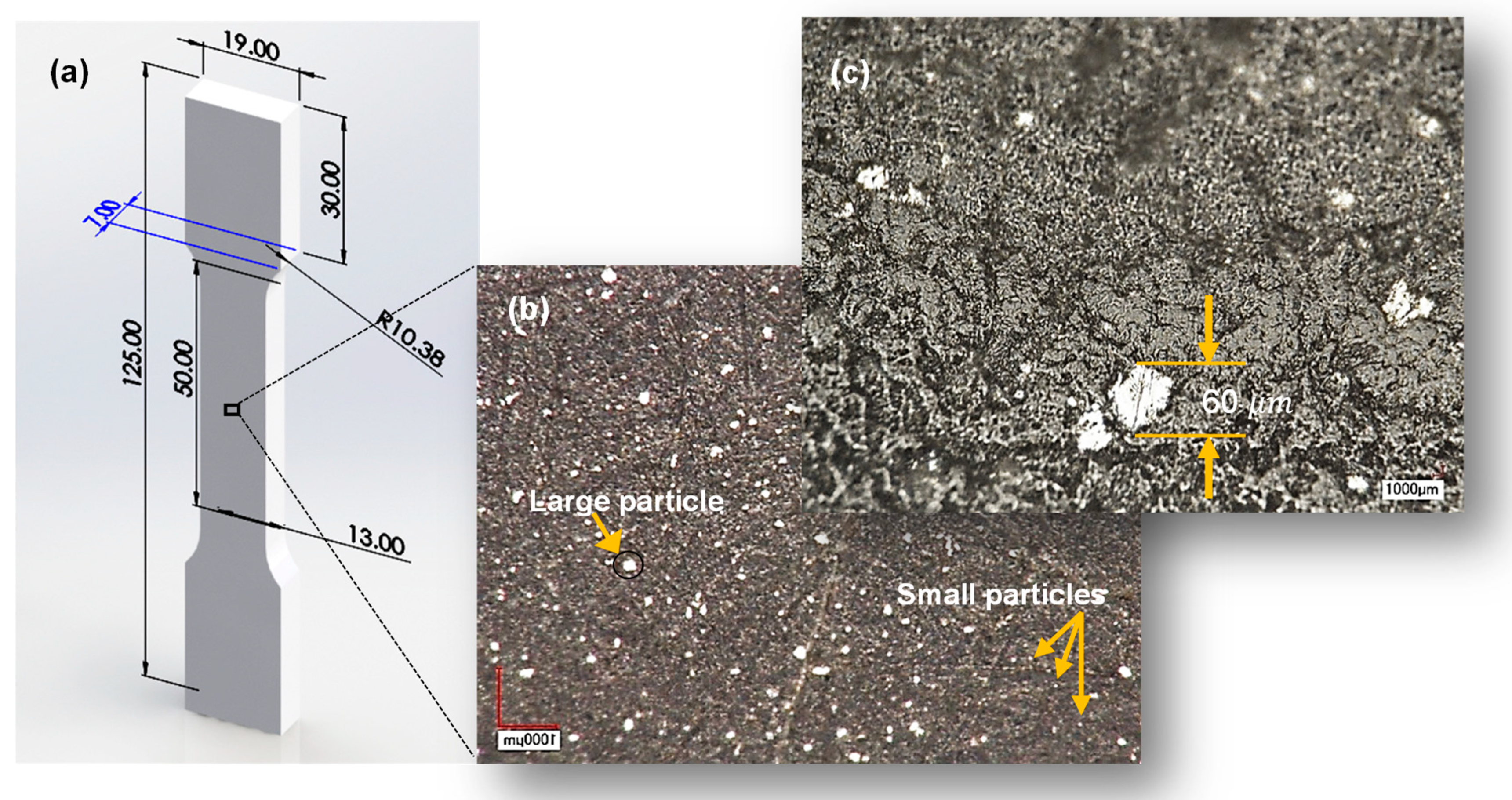
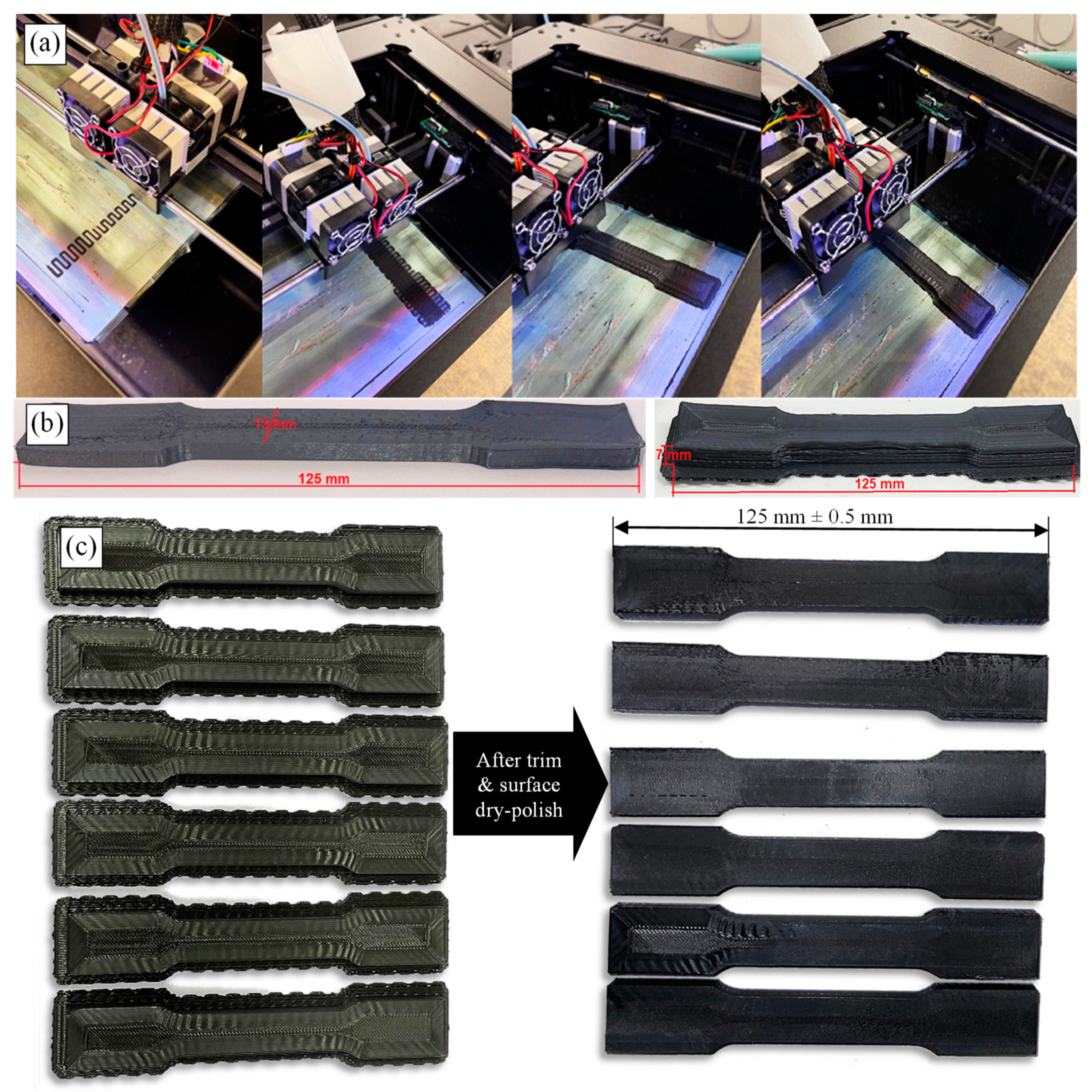

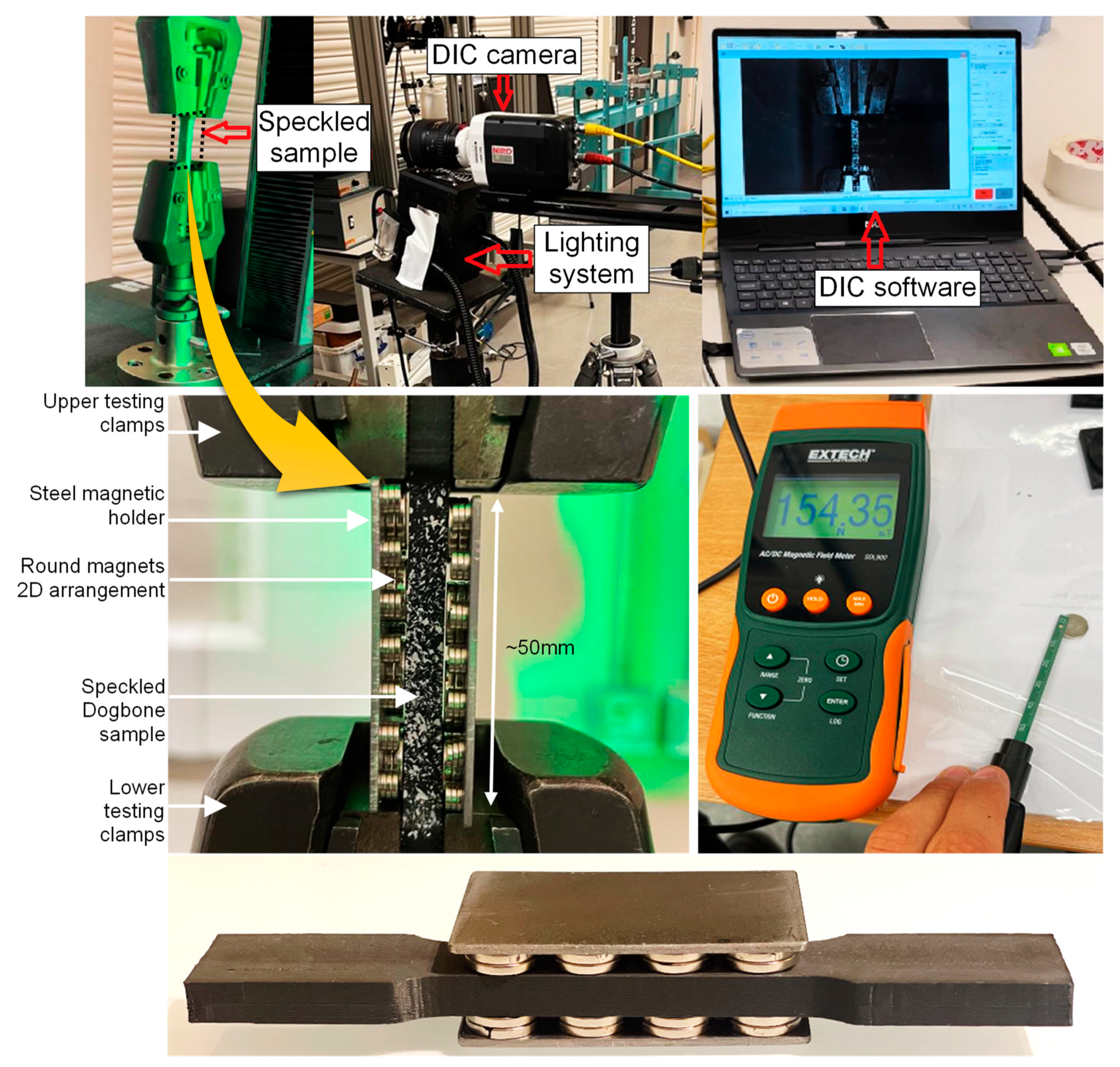
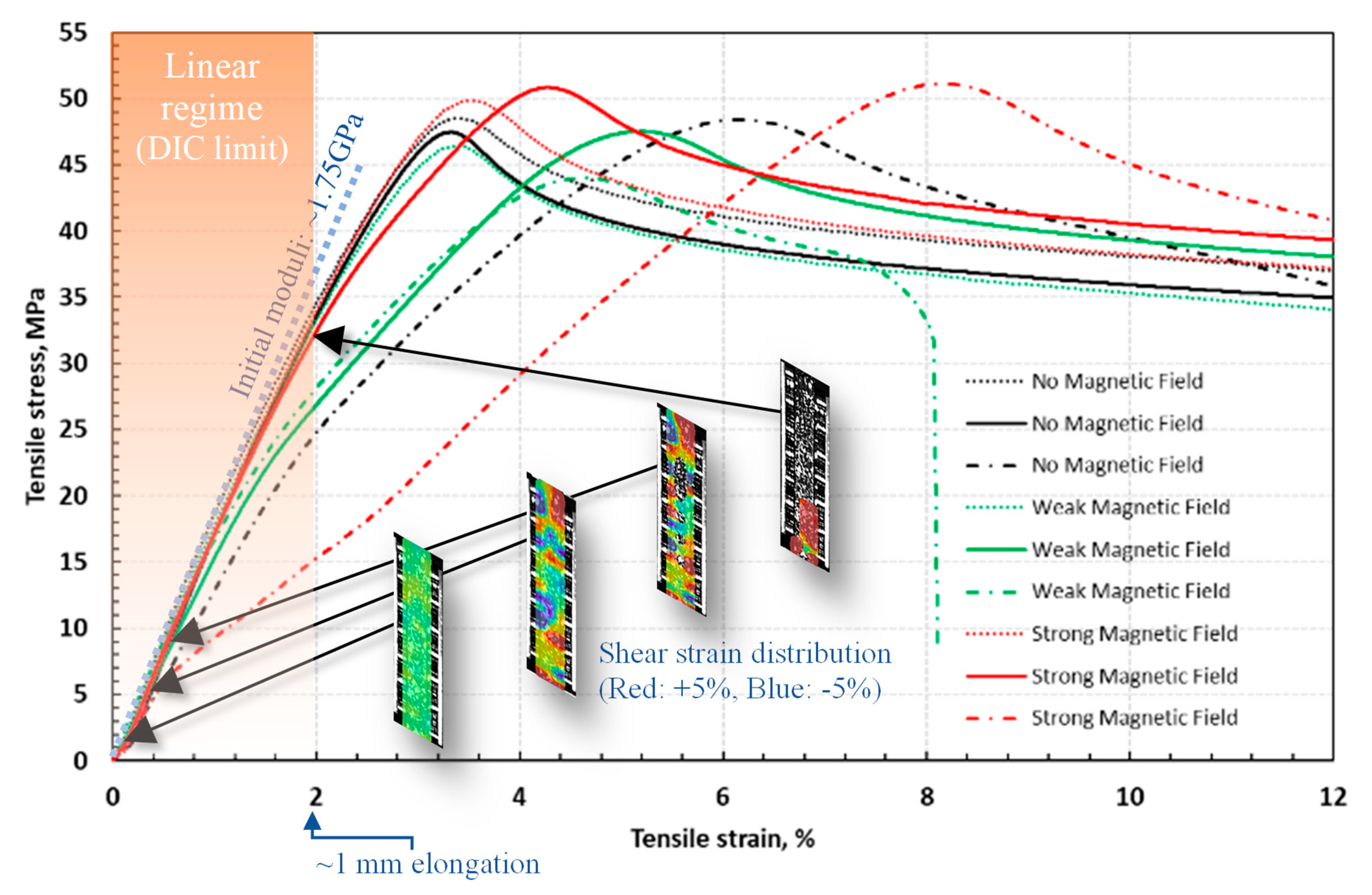



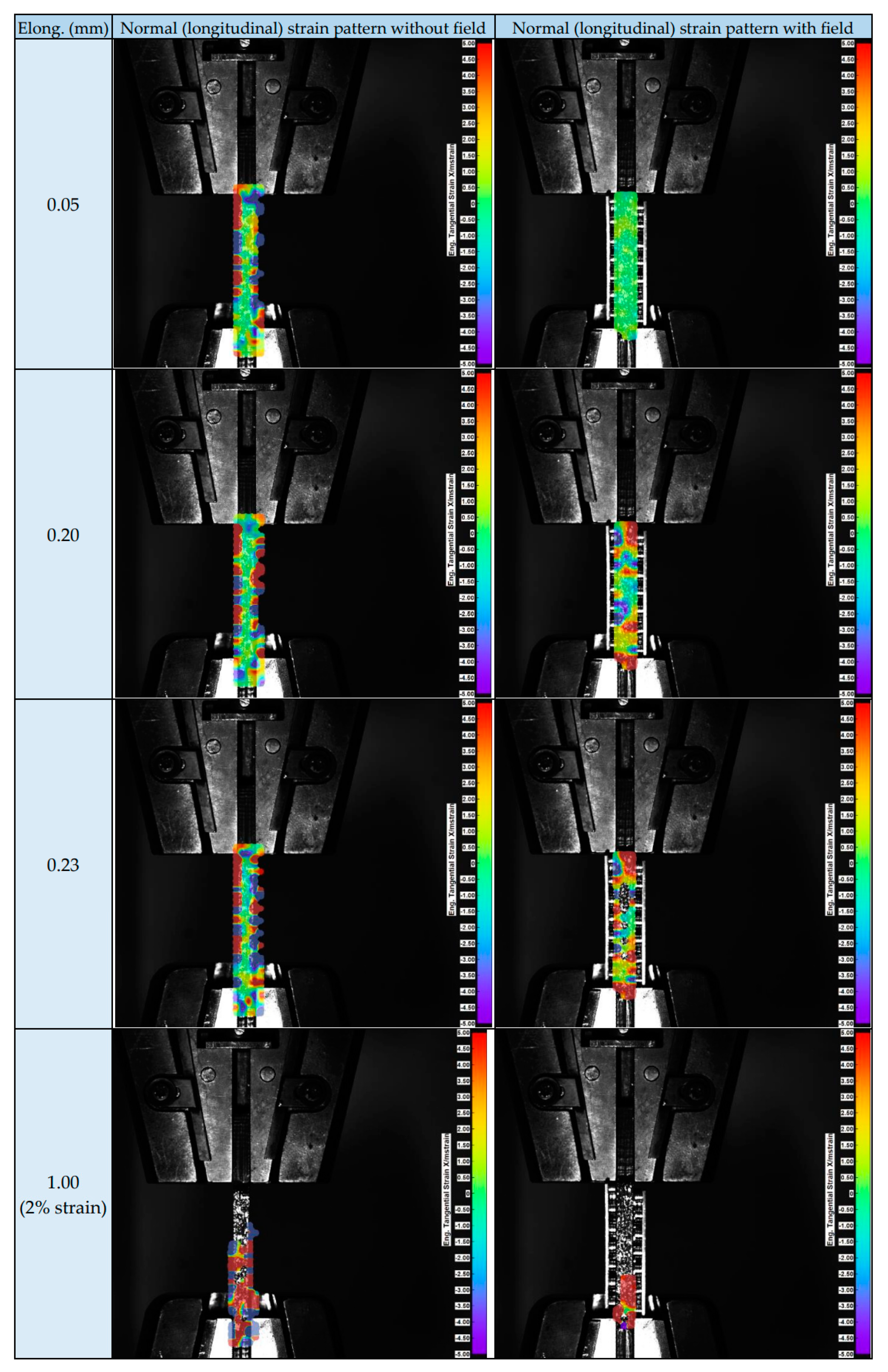
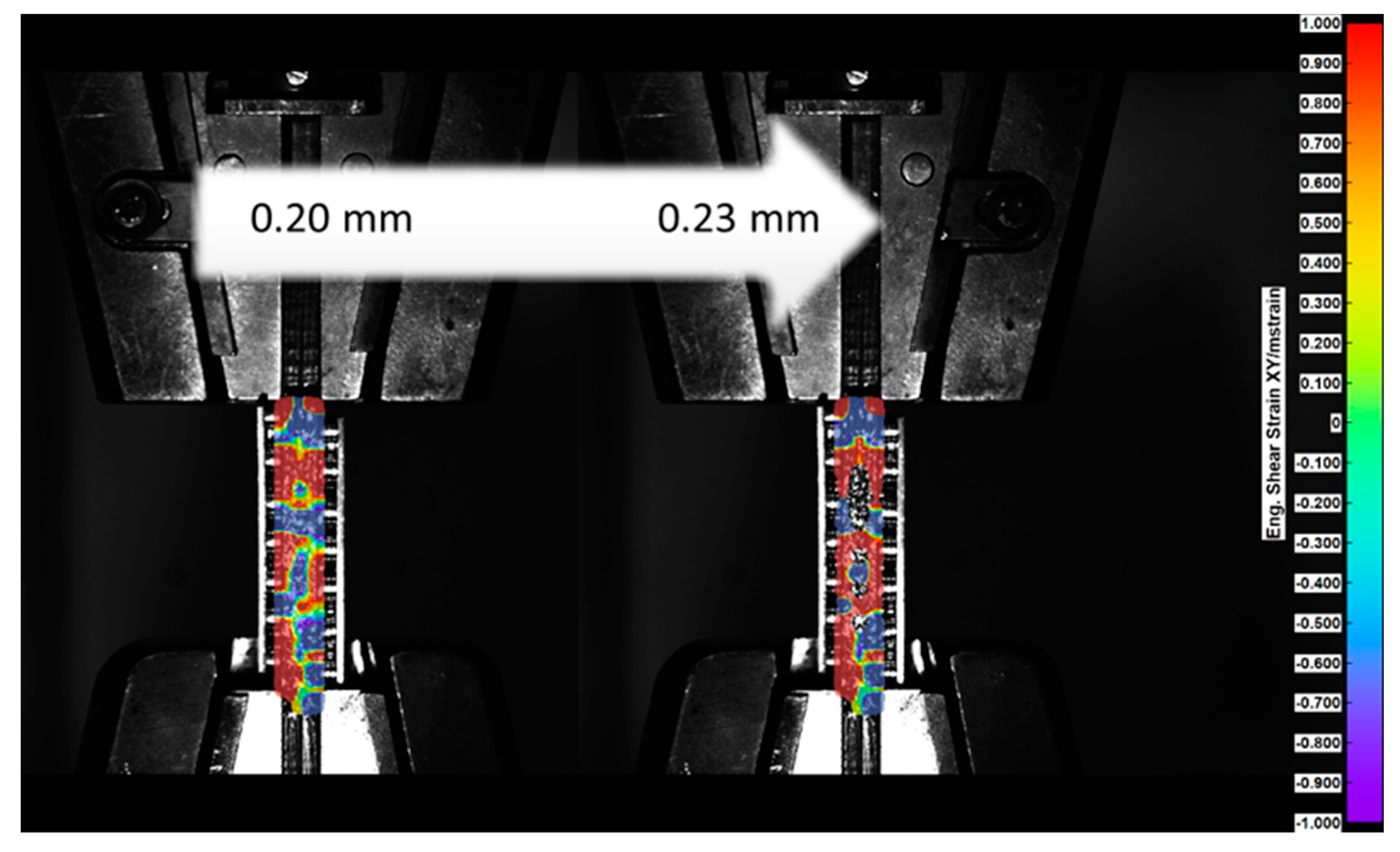
Disclaimer/Publisher’s Note: The statements, opinions and data contained in all publications are solely those of the individual author(s) and contributor(s) and not of MDPI and/or the editor(s). MDPI and/or the editor(s) disclaim responsibility for any injury to people or property resulting from any ideas, methods, instructions or products referred to in the content. |
© 2024 by the authors. Licensee MDPI, Basel, Switzerland. This article is an open access article distributed under the terms and conditions of the Creative Commons Attribution (CC BY) license (https://creativecommons.org/licenses/by/4.0/).
Share and Cite
Mucolli, A.; Midmer, A.; Manolesos, M.; Aldosari, S.; Lira, C.; Yazdani Nezhad, H. Low Magnetic Field Induced Extrinsic Strains in Multifunctional Particulate Composites: An Interrupted Mechanical Strengthening in 3D-Printed Nanocomposites. J. Compos. Sci. 2024, 8, 231. https://doi.org/10.3390/jcs8060231
Mucolli A, Midmer A, Manolesos M, Aldosari S, Lira C, Yazdani Nezhad H. Low Magnetic Field Induced Extrinsic Strains in Multifunctional Particulate Composites: An Interrupted Mechanical Strengthening in 3D-Printed Nanocomposites. Journal of Composites Science. 2024; 8(6):231. https://doi.org/10.3390/jcs8060231
Chicago/Turabian StyleMucolli, Andiol, Alden Midmer, Marinos Manolesos, Salem Aldosari, Cristian Lira, and Hamed Yazdani Nezhad. 2024. "Low Magnetic Field Induced Extrinsic Strains in Multifunctional Particulate Composites: An Interrupted Mechanical Strengthening in 3D-Printed Nanocomposites" Journal of Composites Science 8, no. 6: 231. https://doi.org/10.3390/jcs8060231






